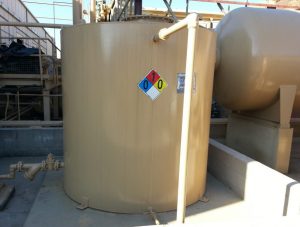 March 1 is the deadline for submission of EPCRA Tier II forms.
March 1 is the deadline for submission of EPCRA Tier II forms.
If you have hazardous chemicals at your facility that mandate a Safety Data Sheet (SDS), you may need to submit Tier II forms under the Emergency Planning and Community Right-to-Know Act (EPCRA). Only chemicals that are in excess of established thresholds need to be reported.
The reporting thresholds are:
- Extremely Hazardous Substances (EHSs): 500 pounds or the threshold planning quantity (TPQ), whichever is lower. (EHSs and their TPQs are listed in 40 CFR part 355, Appendix A and Appendix B).
- All other hazardous chemicals required to have an SDS: 10,000 pounds
Here is the TPQ for some common chemicals found at Bureau of Land Management facilities:
- 80 lead-acid backup batteries (sulfuric acid is an EHS)
- 3,000 gallons of propane
- 1,562 gallons of heating oil
- 820 gallons of retardant
- 2,000 gallons of gasoline
If your facility has hazardous chemicals present at any one time during the year in quantities equal to or greater than threshold levels, you need to submit Tier II forms March 1 each year regarding information on hazardous chemicals present the previous year.
Generally, send the completed Tier II form to each of the following organizations: State Emergency Response Commission (SERC), Local Emergency Planning Committee (LEPC), and the fire department with jurisdiction over your facility.
Some states may have specific requirements for reporting and submission of the Tier II inventory form and/or the state reporting form or format.
Chemicals that must be reported include:
- Battery Acid
- Diesel Fuel
- Fuel Oil
- Gasoline
- Kerosene
- Natural Gas
- Nitrogen
- Oxygen
- Road Salt
- Sawdust
- Transformer Oils
- Windshield Washer Fluid
 Bob LaRosa, PE, is a professional environmental engineer with more than 30 years of experience. He has assisted Federal and private clients with a variety of environmental support projects, including multimedia compliance auditing, EH&S training and curriculum development, SPCC plan development, hazardous materials and hazardous waste management plan development, water system management plan development and implementation, and ESAs.
Bob LaRosa, PE, is a professional environmental engineer with more than 30 years of experience. He has assisted Federal and private clients with a variety of environmental support projects, including multimedia compliance auditing, EH&S training and curriculum development, SPCC plan development, hazardous materials and hazardous waste management plan development, water system management plan development and implementation, and ESAs.